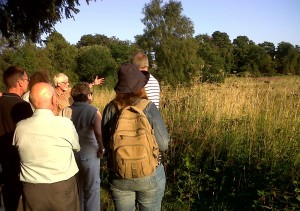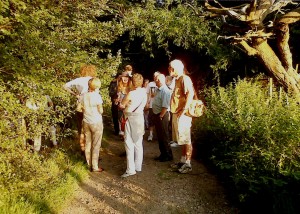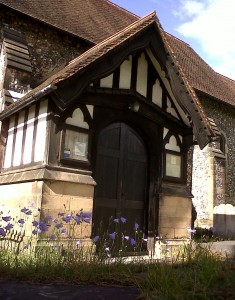The well-attended Bexley Natural Environment Forum meeting on July 23rd looked at a couple of long-running problem areas. These were the Vicarage Road Site of Importance for Nature Conservation in Old Bexley, which has been subjected to repeated bulldozing, and the unmetalled part of Tile Kiln Lane where there have been a number of instances of fly-tipping.
The walk began at St. Mary’s churchyard Old Bexley, where the Harebells, an increasingly rare plant in London, were in flower on a couple of graves. There were also a few in the grass, and numbers could easily be improved with a more sensitive mowing regime.
The group then went out onto the footpath to Churchfield Wood to look at the effects of the ignorant and irresponsible management by private owners or their agents. This had been a fantastic scrub site, and was the last place in Bexley (2010) where a Nightingale was heard. There has been an at least temporary cessation of indiscriminate bulldozing, and a good number of saplings were re-growing.
If any of the several owners of parts of this site, which was sold off in lots by an outfit called Surveyline, reads this, please get in touch with us about possibilities for wildlife sensitive management. NOTE that Viviparous Lizards have been recorded on this land, and further bulldozing will be treated as a breach of the law against deliberate killing and injury of these animals and will be reported to the police.

BNEF members at the Vicarage Road site listen to Ralph Todd, who informed us that he recorded the last Nightingale heard in Bexley in the (since bulldozed) scrub here back in 2010. The UK Nightingale population declined by 53% between 1995 and 2008.
The party then made its way up to the Tile Kiln Lane area, where we looked at fields owned by group member Norman Pearson. We were particularly impressed by the results of his tree-planting efforts, which have resulted in what is now a 30 year old woodland, which neighbours got Ordnance Survey to name Norman’s Wood, since they had no formal name for it on their maps.

BNEF members come out of the maturing native woodland planted by Norman Pearson on a field nearly 30 years ago.
Norman also talked about his ongoing efforts to get the Council to take serious action to stop fly-tippers being able to gain access to the unmade section of Tile Kiln Lane.
The evening was rounded off by (vegan!) beer in Norman’s garden, where a large number of shortly-to-metamorphose Newts were to be seen in his large pond.

